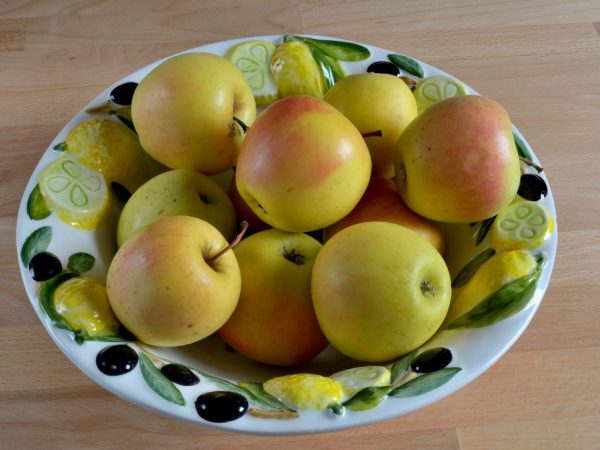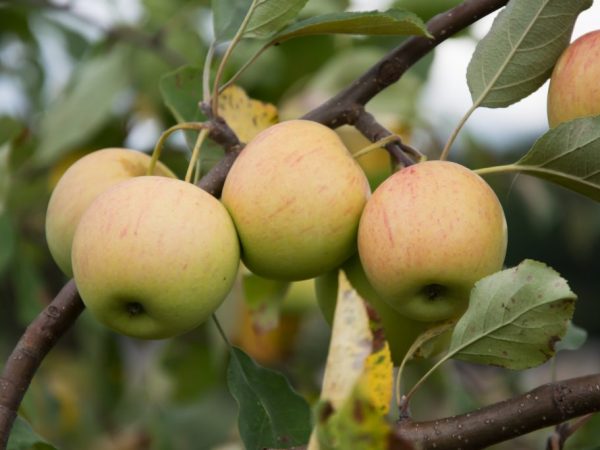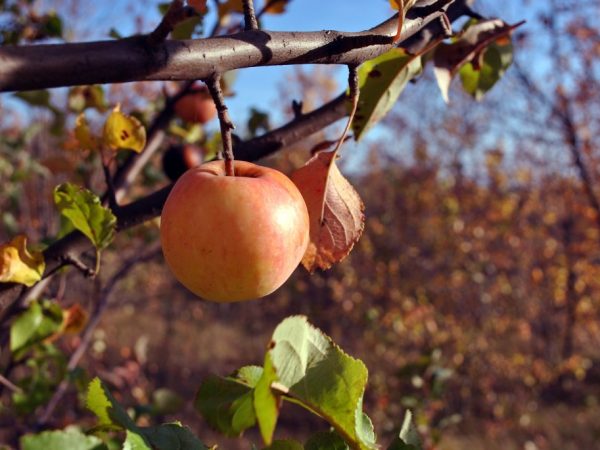Varietal characteristics of the apple tree Orlovsky pioneer
The popular apple tree Orlovsky Pioneer has proven itself well not only in Russia, but also in Europe. Widely cultivated for both implementation and personal use. The hybrid was bred over 45 years ago by crossing Antonovka and SR-0523 varieties.
- Variety characteristic
- Description of the tree and fruit
- Advantages and disadvantages
- Taste
- Features of ripening and fruiting
- Yield
- Pollinators
- Winter hardiness
- Landing
- Timing
- Technology
- Care
- Watering
- Top dressing
- Pruning
- Formation of the trunk
- Protection against diseases and pests
- Possible diseases
- Pests
- Gardeners reviews

Varietal characteristics of the apple tree Orlovsky pioneer
Variety characteristic
The main features of this apple tree are:
- high productivity;
- scab resistance;
- average height;
- high growth rate.
The tree gives harvest annually. The height of the apple tree is up to 4 m. The tree grows by an average of half a meter per year.
Description of the tree and fruit
The tree is characterized as follows:
- dense crown of a cylindrical shape;
- branches are straight, taper to the crown;
- smooth light bark;
- kidneys are small, conical;
- shiny green leaves, long;
- during flowering, the petals are pinkish;
- the buds are bright pink.
The fruit is medium, has a flattened shape. The peel is glossy. When harvested, the fruits are green, after ripening they turn yellow. Blush and streaks may be present. Medium peduncle.
The shape of the apple tree crown can vary from columnar to cylindrical. This will depend on how the grower is pruning the branches.
Advantages and disadvantages
The Orlovsky pioneer apple tree has a number of advantages:
- immunity to fungal diseases;
- annual harvest;
- high quality fruit;
- does not need processing, reducing the costs of the gardener.
The disadvantages include a slight drying out of apples if improperly removed and stored.
Taste

Sweet and sour apples
Apples are sour and have a sweet aftertaste. The pulp is hard, chipped, a lot of juice. There is no aroma.
The chemical composition includes:
- 11% sugar;
- 0.8% acids;
- 16.2 mg / 100 g of ascorbic acid;
- 16.4% pectin.
Features of ripening and fruiting
The description indicates that the apple tree belongs to the early-growing varieties. Already at the 4th year of life, she begins to produce crops. This increases the popularity of the variety, because a large number of apple trees begin to bear fruit after 6-7 years. With proper care, the tree produces a regular crop.
Yield
Harvesting takes place at the end of summer. Apples are densely located on the branches and hold on to them for a long time, so you can remove the fruits before frost. One tree produces about 100 kg of fruit per year. The collected fruits are stored in a cold place until mid-winter.
Pollinators
The apple tree of the Orlovsky Pioneer variety is pollinated by insects, so it will be good if an apiary is located near the site. When she hatched, the first pollination was from the parent tree - from Antonovka. The second was done with SR-0523. All subsequent ones were carried out by insects.
Winter hardiness
The apple tree is highly resistant to low temperatures. It tolerates frost and winter drought well. There are cases when the apple tree tolerated temperatures down to -30 ° C.This allows the tree to be grown in the northern regions.
Landing
The determining factor in a successful landing is the choice of location. It should go so that the tree is located in an area with good access to light. Make sure that the groundwater does not wash out the roots. You need to either place the seedlings on a hill, or build a barrier structure.
Timing
Usually apple trees of this species are planted in the middle of summer. The main peak occurs at the end of July. This variety is planted in spring. If the snow has melted, sowing can be started already at the end of March.
Technology
Trees are planted according to the 5 by 5 principle: each such fruitful tree should be located at a distance of 5 m from the other on each side. If a gardener expects to plant a large number of apple trees, he needs to take care of the size of his site.
Trees grow strongly and may not allow neighbors to develop and bear fruit normally. The seedling is placed in a hole up to 70 cm deep and 1 m wide. After planting, you need abundant watering.
Care
In order for a tree to bear fruit and grow abundantly, you need special care for it. The key to success is periodic feeding, regular watering, timely pruning of old branches and processing to prevent the appearance of pests.
In the spring, you need to carefully examine the tree: prune branches and heal wounds after winter. In the summer, they loosen and clean the land near the tree, water it abundantly and carry out treatments for parasites. In the fall, the trunks are whitened, fertilized and insulated for the winter.

With proper feeding, there will be a good harvest.
Watering
The tree does not need special watering if there is regular and heavy seasonal rainfall. In a hot summer, watering the Orlovsky pioneer apple tree once a week will be enough: 1 bucket of water under each tree. It is necessary to dig up the near-trunk circle and pour water into it or water it along the projection of the crown.
Top dressing
The tree needs regular feeding. This event should be held in the spring and autumn.
In the spring, any fertilizers containing nitrogen are applied. In the fall, only mineral products can be applied. Nitrogen mixtures enhance metabolic processes, and the tree begins to form shoots.
In the spring, 500 g of urea is also used per one trunk circle, 5 buckets of manure, droppings or humus. Before that, you need to fluff and loosen the soil. In drought, urea is dissolved in a bucket of water. In the rainy season, dry fertilizers are added.
It is recommended to add urea during the flowering period: 250 g per bucket of water. You can add half a bucket of manure and a bucket of water.
When the tree stops blooming, sodium humate is added: 10 g per 10 buckets of water, 3 buckets of solution are consumed per tree.
In the fall, "talkers" are prepared, which include 20 g of potassium, 20 g of calcium, 40 g of superphosphate and a bucket of water. For one tree - 10 liters of ready-made composition.
Pruning
There are two types of pruning - supportive and rejuvenating. With supportive treatment, you need to remove old branches, making room for new ones, so that they do not grow sideways, but tend upward.
Anti-aging pruning is done for branches that are over 4 years old. After pruning, processing with a garden pitch is required.
Formation of the trunk
To form a stem at a height of 60 cm, a bud is selected, from which the main branch will go, the remaining buds are cut off. Then another kidney is taken after 30 cm, it is left. The rest of the kidneys are removed.
Protection against diseases and pests
Having a high immunity to fungi, the tree is not affected by these infections. But due to improper care, the risk of other diseases in the apple tree is likely.
Possible diseases
The description of the variety indicates several diseases that are inherent in it:
- bacterial burn. It is treated with copper sulphate, processed with the Hom substance;
- black cancer. For its prevention, fertilizing rich in potassium is used. If the tree is sick, you need to cut off the affected branches and cover up the saw cut with garden pitch.
Pests
The apple tree Oryol pioneer can be attacked by such pests:
- aphid.Destroyed by treating wood with a solution of laundry soap;
- flies and apple moths. The tree is treated with karbofos;
- leaf roll. Spraying with nitrophen wins it;
- moth. It is destroyed by chlorophos.
Gardeners reviews
This variety is popular in home gardens and on an industrial scale. It is unpretentious in care, gives a regular and tasty harvest. Planting an apple tree is not a big deal.
Most gardeners come to the conclusion that this variety is one of the most optimal for planting in terms of the cost of care and the resulting crop. The tree is unpretentious: it is enough to cut it off in time and form a stem correctly when planting. Then you will become the owner of a gorgeous, and most importantly regular, harvest.

